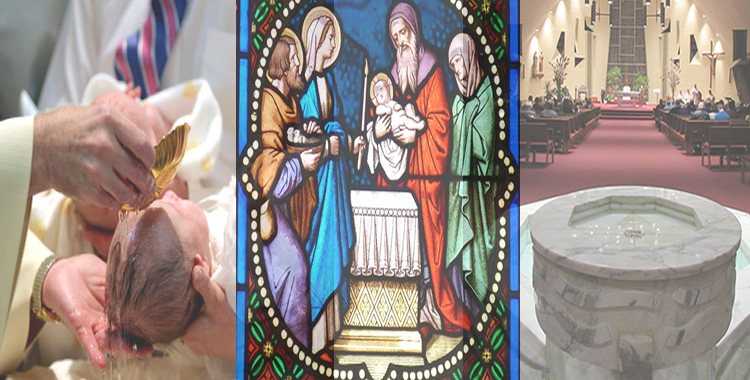
In the Catholic Church, infants are baptized to welcome them into our Catholic faith and to free them from original sin with which they were born. We are happy to welcome your child into the faith.
Baptisms take place on Sundays at 12:30 PM at St. Celestine on the second and fourth Sunday of the month and at 12:30 PM at St. Cyprian on the third Sunday.
Arrangements for Baptism and Baptismal preparation must be made in advance by calling Ruthanne Swiatkowski at 708-453-2555 ext. 5017 or via email rswiatkowski@stguerinparish.org.
The Sacramental fee is $100 and may be submitted at the time of the Baptism. Should you wish to personalize the Baptismal bib garment, please inform us and it will be sent to you. Otherwise, it will be provided at the time of the Baptism.
Baptismal Class
A Baptismal Preparation Class is required for parents having children who are infants or up to 5 years old being baptized. They are usually held on the first Wednesday of the month at St. Cyprian at 7 PM with Deacon Roland. Contact Ruthanne Swiatkowski at 708-453-2555 ext. 5017 to sign up.
If you are interested in Baptism for older children or for adults, please call Ruthanne Swiatkowski at 708-453-2555 ext. 5017 to discuss your options.
Godparents
At least one of the chosen Godparents needs to have been baptized, have received First Communion, have been confirmed and be a practicing Catholic. Please fill out the Godparent Verification form and scan or return it with a copy of the Godparents’ Confirmation certificate to rswiatkowski@stguerinparish.org.
Baptismal Godparent Parish Registration Form (PDF)
There are Church requirements for Roman Catholic Godparents.
- A child must have one practicing Roman Catholic Godparent in good standing with the Church. This Catholic godparent usually must be at least 16 years old and be mature enough to understand, accept, and carry out the duties of a godparent.
- A Godparent must have received the Sacraments of Initiation: Baptism, Eucharist, and Confirmation.
- A Godparent must be living an exemplary life consistent with faith and morals as taught by the Roman Catholic Church.
- A Godparent must be actively practicing the faith.
- A non–Catholic, baptized Christian may be chosen as a Christian Witness, as long as one Godparent is Catholic.
The Sacrament of Baptism
In the Sacrament of Baptism, water is poured upon the person saying, “I baptize you in the name of the Father, and of the Son, and of the Holy Spirit.” The person baptized is cleansed of all sin and incorporated into Christ and made a member of His Body, the Church. Through Baptism, one receives sanctifying grace, the virtues of faith, hope, and charity, and the gifts of the Holy Spirit.
What do the Baptismal Symbols mean?
Water is for cleansing and is a sign that our sins are washed away. Baptism cleanses us of original sin with which we are all born and, in the baptism of adults, of every sin committed prior to baptism. Water is also necessary for life and so is a sign, too, that the life of the risen Christ is ours.
The Sign of the Cross – When the cross is traced on a child’s forehead, we as Christians remember that Jesus experienced a fully human life and will be with your child throughout their life. Like Jesus, they will have sorrows and joys, but will never be alone.
Oils – Oil in the past was a healing remedy and a sign of power. Kings, prophets, priests, and the sick were anointed so that they might be strengthened and healed. Entering the community of faith is an important moment in your child’s life, one that calls for future strength and dedication. By using oil, the church dramatizes its prayer that this child will be strengthened by God and by the prayer of the whole community.
Candles – Candles symbolize Christ who is the Light of the World. The baptismal candle is lit from the Easter candle, which stands near the altar at Easter as a sign of the risen Christ. The baptismal candle reminds us that the light of Christ has entered the child’s life; and its flame symbolizes the flame of faith that will burn through the life of the child.
White Garment – This garment is a relic of the new clothes worn by Christians after baptism in the first centuries. It is a sign of innocence and the new life or resurrection.
The Baptismal Ceremony – The ceremony begins with a warm welcome to the family beginning in the vestibule or outside the church. The children are signed with the cross and the assembly processes inside to the front of the church where they are seated.
Once inside, the Gospel is proclaimed and a brief homily is given. The assembly then processes to the Baptismal Font in the back of the church.
At the font the people are gathered in a circle and the anointing and actual baptism takes place. The white robe is also placed on the baby. The assembly then processes to the altar.
At the altar the assembly gathers with the lighted baptismal candle, we say the Lord’s Prayer and receive a parental blessing.
The process represents our faith journey. This movement of the people through the church duplicates our movement through life as we seek to draw closer to God. We come to the church seeking to be received into the Body of Christ. Having been welcomed, we are drawn to the ambo to hear God’s word. Strengthened by the Word, we move toward the Living Water of Baptism to die and rise with Christ to new life. At last, united in Baptism, we gather around the altar where time and again, throughout our lives, we will encounter the Lord in the bread and wine of the Eucharist.